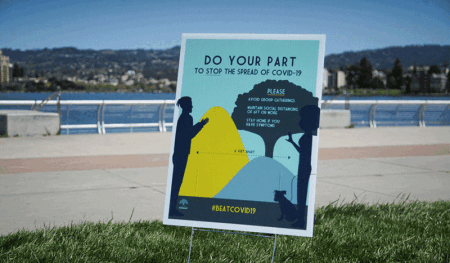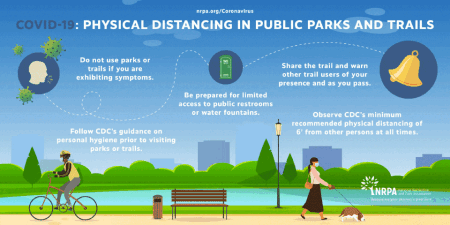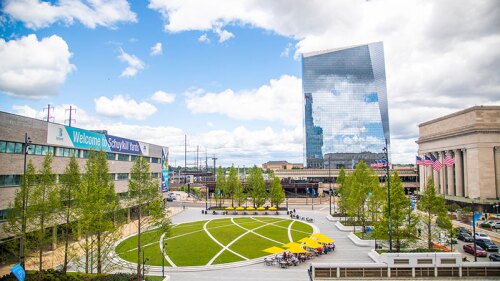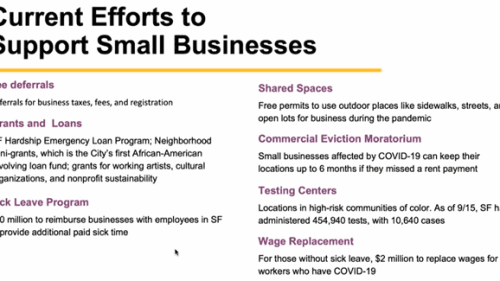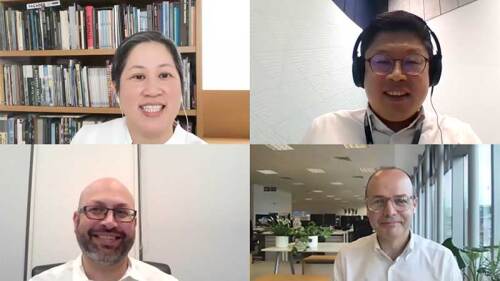Parks and open space have provided a much-needed respite from the quarantine necessary in many cities to slow the spread of COVID-19, according to parks and health experts participating in a recent webinar hosted by ULI and the National Recreation and Park Association (NRPA), underscoring the mental and physical health benefits of access to the outdoors.
ULI, NRPA, and the Trust for Public Land are partners in the 10 Minute Walk campaign, dedicated to improving access to safe, high-quality parks and green spaces in cities throughout the United States.
“Confronting COVID-19: Parks, Public Spaces, and the Pandemic,” moderated by Rachel Banner, director of park access at NRPA, featured insights from Nicholas Williams, director of the city of Oakland Parks, Recreation, and Youth Development in Oakland, California; Kathryn Ott Lovell, commissioner of the city of Philadelphia Parks and Recreation in Philadelphia; Janet Fulton, chief of the physical activity and health branch at the U.S. Centers for Disease Control and Prevention (CDC) in Atlanta; and Jennifer Murphy, team lead for the CDC’s Water, Sanitation, and Hygiene (WASH) Team for the COVID-19 Response. Nan Rohrer, president of Midtown Baltimore, also offered observations as an additional participant.
The event was the latest in a series of webinars offered by ULI to explore how the real estate industry is being affected by the virus and the industry’s response. The webinar is free for all to access at ULI’s Knowledge Finder.
A recent NPRA survey of consumers found that 83 percent of adults consider exercising at local parks and spaces essential to maintaining physical and mental health during the pandemic, and 59 percent believe that it is “very or extremely” essential to exercise in parks and green space to relieve crisis-related stress and remain healthy.
“At a time when most other places are shut down, parks and open spaces remain one of the few places where people can get outside,” Banner said. “We want to do all we can to protect these spaces and support the park and recreation professionals who are making these places possible.”
NPRA is providing its members with a variety of resources on the safe use of parks, trails, and open spaces, including signs emphasizing social distancing. It is also starting to assist with community strategies for safely reopening closed public spaces such as sports fields and picnic areas as the coronavirus diminishes, she said.
Despite parks being a highly valued public amenity, Banner noted that summer plans for activities and programs “continue to be on hold” at most parks and recreation agencies. What they might be able to offer hinges not just on mitigation of the virus, but also the agencies’ financial status, she said, noting that the economic fallout has caused many agencies to make substantial budget cuts.
“We know from the last recession [in 2008] that parks and recreation were among the hardest-hit agencies and the slowest to recover. It is essential that these agencies receive the funding needed to provide access to all in times of calm and crises,” Banner said.
Williams explained that because parks are places for people to “keep their mentalities together and get out of the house,” the Oakland agency initially tried to keep as many park facilities open as safely possible under the state’s stay-at-home order, using signage and social media to reinforce social distancing and discourage group gatherings.
However, as the crisis worsened, the agency was forced to adopt a more direct approach with sign messaging and amenity closures, he said, adding that the agency has encouraged use of neighborhood parks to minimize visits to large, busier regional parks.
Despite its stepped-up efforts on safe park use, the agency is concerned that people are becoming less cautious, Williams said.
“After weeks upon weeks of sheltering in place, people are getting antsy, they are congregating in parks, they have distancing fatigue and they are not wearing face coverings as much as we would like. We are actively trying not to police community members during this crisis, and we do not want to involve the police. We are just trying to use community messaging and park ambassadors to spread information,” said Williams.
As has happened in many other cities, the highest number of coronavirus cases in Oakland coincides with the lowest-income neighborhoods, where most residents are people of color. Williams said that the parks and recreation agency has reached out to these neighborhoods to distribute personal protective equipment such as face masks, educate residents about social distancing, and raise awareness about the severity of the crisis.
“This is another layer of disparity for people in Oakland who are the hardest hit with other disparities. We have had to close basketball courts and soccer fields due to the difficulty in maintaining social distances, but were able to keep parks and trails open, so what we are trying to do is have an equitable approach to what is accessible to Oakland residents,” Williams said.
The agency has been strategic in determining which recreation centers to keep open and use as food distribution locations, and it is working to ensure that when centers are reopened for recreational use, the openings will be evenly distributed throughout Oakland. In the interim, the agency is offering virtual summer programs, including exercise classes for adults and children, coding classes, and math and reading classes to help children avoid the “summer slide” on what they learned during the past school year, Williams said.
“As we reinvent our programming, we are trying to be creative,” he said.
In Philadelphia, where the hundreds of recreation centers and thousands of sports courts and fields are closed, the parks and recreation agency has worked diligently to keep the city’s 10,000-plus acres (4,000-plus ha) of parks and 200-plus miles (322-plus km) of trails accessible and safe, Lovell said. Early during the city’s shutdown, use of the waterfront trails surged, resulting in unsafe crowding as joggers, bikers, and walkers competed for use.
As a result, the agency worked with the city’s transportation department to close a major thoroughfare next to one of the most popular urban trails, freeing up more space to accommodate social distancing, she said. It also initiated a significant signage campaign to remind people to stay in their neighborhoods, leave space between themselves and others, keep moving on trails to prevent bottlenecks, limit time spent on trails, and sanitize.
In addition, the agency has reassigned about 300 of its employees to assist with providing meals and packages of food to residents, converting some of its centers into distribution centers. And, as part of its efforts to serve the city’s neediest population, the agency has worked with nonprofit partners on mask-making campaigns to offset a shortage of face coverings, Lovell said.
Yet, despite the key services being provided by agency employees, and the overall acknowledgment of parks providing vital benefits throughout the crisis, the agency is facing a significant budget cut for fiscal year 2021. The combined health and economic impacts of the virus have resulted in the closure of all the city’s public pools this summer; some summer camps are a possibility “if we can get to a place where they can be done safely,” she said.
As an alternative, the agency is organizing “hyper-local engagements” for children through a program that permits neighborhood streets to be temporarily closed each day for meal distributions and eventually for safe, structured play experiences. “This is based on the idea that if the kids cannot get to a recreation center, then we make sure we get to kids,” Lovell said.
Rohrer explained that Midtown Baltimore, which is funded through a surcharge on property taxes levied on commercial and residential properties in the city’s midtown, exists to augment city services provided in five community benefits districts, also known as business improvement districts. In addition to providing street cleaning and neighborhood safety patrols, the agency assists with park upkeep, she said. Although it has had to limit its services during the COVID crisis, the agency has continued to keep parks and open spaces clean and safe by recruiting volunteers through social media.
“If people feel comfortable going out and working on projects, they are welcome to do so as long as they do it safely. We have found that people want to be helpful in their communities, but they don’t know how. Helping to clean parks is an easy way for people to give back on their own time, in a nonthreatening and noncommittal way,” Rohrer said. “From this experience, we are hoping to build a new volunteer base for park advocates in the post-COVID world.”
Fulton offered advice from the CDC on safe use of parks and open spaces, emphasizing the urgent need to continue behaviors that minimize exposure and spread of the virus.
“We all know that getting outside and being active provides so many long-term health benefits, but now parks are providing immediate benefits,” Fulton said. “Physical activity helps you feel better, sleep better, and think better, and those benefits are especially important now to help reduce depression and anxiety.”
She noted that the CDC’s guidance for park use includes now-familiar “do’s and don’ts” that still merit repeating: visit parks close to home; plan for visits by bringing water and hand sanitizer along; wear a face covering; do not go to crowded places; avoid all playground equipment; and, perhaps most critical, stay at least six feet (2 m) from others at all times.
“We [at the CDC] know social distancing is hard—it is the nature of our culture to be together. But it is important for everyone’s health to keep away from people. We know from science that this works to slow the spread of the disease,” Fulton said.
Murphy explained the CDC’s three main principles for cleaning and disinfecting surfaces to reduce the risk of virus exposure:
- Cleaning and disinfection should be effective: First, clean dirty surfaces with soap and water, then disinfect with an Environmental Protection Agency–approved over-the-counter disinfectant or a homemade solution consisting of one-third cup of bleach per gallon of water.
- Disinfection should be efficient: Disinfect areas that are frequently touched by several people, including doorknobs, light switches, phones, faucets, sinks, handles, and remote controls.
- Cleaning and disinfection must be safe: Be sure to understand how to apply disinfectants and what concentrations should be used. Wear protective equipment such as rubber gloves, ventilate the disinfected area, and store disinfectants properly.
Webinar participants were asked about how to plan parks and open spaces for the future based on lessons learned from the pandemic. “The more flexible space can be, the better,” Lovell said. “Spaces that can be used for multiple audiences and multiple needs are better, and having more open space to reduce crowding is better.”
Lovell noted that parks and recreation centers—long positioned as a key part of civic infrastructure—should be promoted and funded as an integral part of human and social services. “For parks to continue to be the economic and community development drivers we believe they are, we can’t let this crisis do things to parks that will have long-term detrimental effects on our cities,” she said.
“The original intent of public parks was to provide access to outdoors for everyone. That is still important, but we must rethink ways that people can safely share spaces, because the need for parks and open space will never decrease,” Williams said.
This webinar is part of a series organized by ULI’s Building Healthy Places Initiative. The goal of the series is to help members understand the role they can play in helping to slow the spread of the disease, help them navigate the long- and short-term impacts of the crisis, help them understand how they can play a role in minimizing adverse impacts on vulnerable people, and help them play a role in urban recovery efforts to ensure that they are equitable and enhance resilience.
The next webinar in the series, “Confronting COVID-19: Insights from Asia,” is scheduled for May 12 from 10:00 a.m. to 11:15 a.m. Eastern Daylight Time. The webinars are generally free of charge and open to ULI members and others. For more information related to COVID-19 and real estate, visit Public Health and Real Estate: Resources on COVID-19 at uli.org.
TRISH RIGGS, a former senior vice president of communications at ULI, is now a freelance writer based in Falls Church, Virginia.

